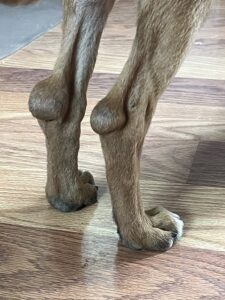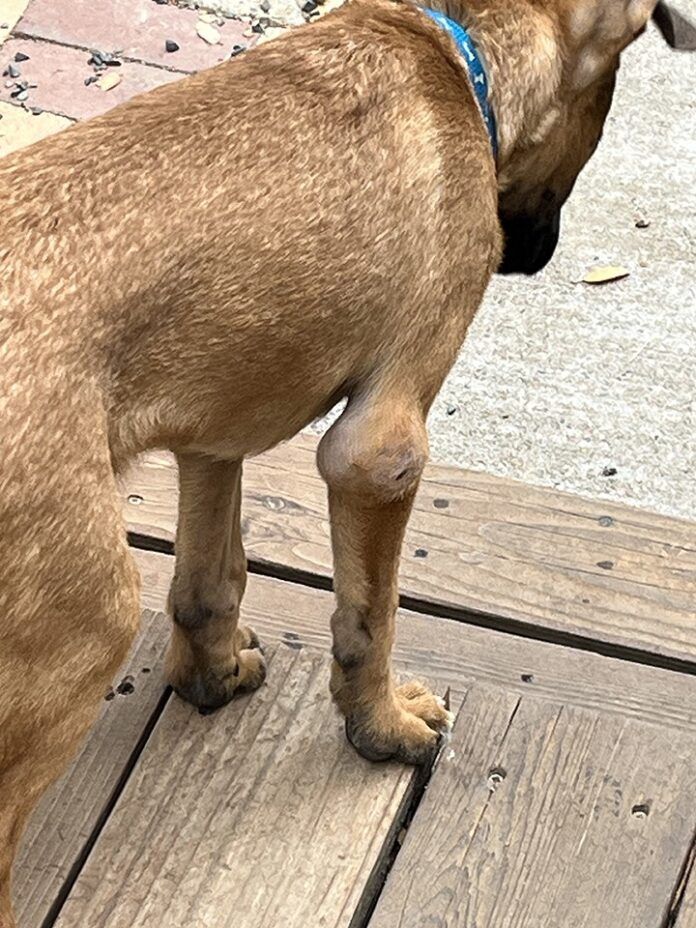A hygroma is a large, fluid-filled lump on a dog’s elbow – or, actually, a fluid-filled lump on any bony point on your dog that frequently comes into contact with the ground when he sits or lays down. Elbow hygromas are the most common, especially in large breed dogs, but some dogs in shelters or other places with hard floors develop hygromas on their hocks. It’s much less common, but very thin dogs may develop hygromas on the bony points on their butts (ischiatic tuberosity) from sitting on hard surfaces.
These fluid-filled sacs develop as a result of repeated trauma or pressure over a bony prominence. Think about the Great Dane or St. Bernard who clunks himself down for a rest on hard surfaces like tile or hardwood floors. This repeated irritation to the elbow causes tissue damage and inflammation, resulting in fluid accumulation.
Uncomplicated elbow hygromas in dogs
Usually, these fluid-filled lumps are what veterinarians call uncomplicated hygromas – meaning they are not painful or infected. Often, we can get hygromas to resolve by protecting the elbows by providing cushioned bedding in any area where he frequently rests – and by limiting his access to areas where he prefers to lay on hard surfaces.
Some owners use protective neoprene sleeves that pad their dogs’ elbows – Dogleggs was one of the first companies that made a product for this purpose, though you can find many others today (search for “dog elbow pads”).
Complicated hygromas in dogs

Because hygromas don’t seem to cause the dog any pain, some owners choose to ignore the swelling. This is a big mistake. Left unaddressed, an uncomplicated hygroma can become a painful, disastrous, complicated hygroma in a hot minute.
Draining an uncomplicated hygroma can remove the fluid accumulation – but this is not recommended because of the risk of introducing infection. Additionally, draining the hygroma does not address the underlying cause, which is repeated trauma and pressure on the elbows. Most drained hygromas will fill again within a day.
Drained or not, some hygromas become infected, at which point they become very painful and won’t heal without veterinary attention. Sometimes the skin surface becomes ulcerated, and sometimes the whole thing breaks wide open. In these cases, treatment with antibiotics alone is usually not enough. The lesion needs to be surgically drained and flushed. To keep it draining while the infection resolves, your veterinarian will place a soft, open rubber tube called a Penrose drain. This stays in place for several days until the drainage slows or stops. Daily bandage changes are required to protect the site and prevent new infection from ascending up the open drain.
Further, unfortunately, this first line approach doesn’t always work. The final option for complicated hygromas that don’t resolve with surgical drainage is surgical removal of the hygroma. This, however, should not be undertaken lightly. Most surgeons reserve this option for severely infected, painful, non-responding hygromas, or if there is suspicion of cancer. Hygroma removal can have severe complications, especially when it comes to healing.
his makes sense when you think about it. The hygroma developed as a result of repeated trauma and pressure on the elbow. It is difficult to protect the elbow from these challenges. Now, add in a surgical incision with sutures whose job it is to keep the skin edges together. In addition to the trauma from lying down, there is so much movement at the elbow joint, it’s almost impossible to immobilize that area to aid healing. Because of these challenges, sutures can fail and incisions can break open. Sometimes special techniques like skin flaps or grafts are necessary to close the surgical wound. Your best bet is referral to a highly skilled, board-certified veterinary surgeon for this procedure.
Take immediate steps to prevent hygromas from getting worse
While a hygroma may not initially be a problem for your dog, it’s not something you should ignore. If you find a soft swelling on your dog’s elbow or other bony prominence, schedule a veterinary exam right away. This is the best way to ensure the swelling is indeed a hygroma, not something worse, and to get advice and guidance on how to treat this one, and prevent the next one. And immediately provide your dog with super-cushioned resting places and prevent his access to hard resting surfaces.






